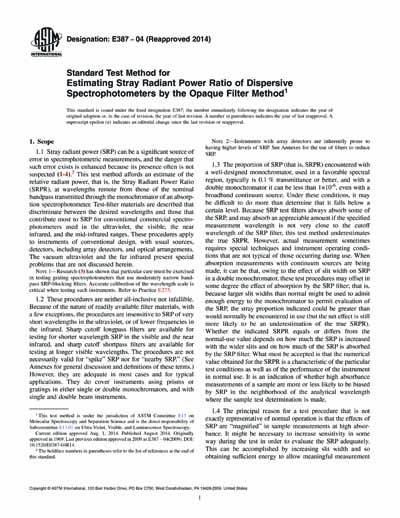Historical
ASTM E387-04(2014)
Standard Test Method for Estimating Stray Radiant Power Ratio of Dispersive Spectrophotometers by the Opaque Filter Method
1.1 Stray radiant power (SRP) can be a significant source of error in spectrophotometric measurements, and the danger that such error exists is enhanced because its presence often is not suspected (1-4).2 This test method affords an estimate of the relative radiant power, that is, the Stray Radiant Power Ratio (SRPR), at wavelengths remote from those of the nominal bandpass transmitted through the monochromator of an absorption spectrophotometer. Test-filter materials are described that discriminate between the desired wavelengths and those that contribute most to SRP for conventional commercial spectrophotometers used in the ultraviolet, the visible, the near infrared, and the mid-infrared ranges. These procedures apply to instruments of conventional design, with usual sources, detectors, including array detectors, and optical arrangements. The vacuum ultraviolet and the far infrared present special problems that are not discussed herein.
Note 1: Research (3) has shown that particular care must be exercised in testing grating spectrophotometers that use moderately narrow bandpass SRP-blocking filters. Accurate calibration of the wavelength scale is critical when testing such instruments. Refer to Practice E275.
1.2 These procedures are neither all-inclusive nor infallible. Because of the nature of readily available filter materials, with a few exceptions, the procedures are insensitive to SRP of very short wavelengths in the ultraviolet, or of lower frequencies in the infrared. Sharp cutoff longpass filters are available for testing for shorter wavelength SRP in the visible and the near infrared, and sharp cutoff shortpass filters are available for testing at longer visible wavelengths. The procedures are not necessarily valid for “spike” SRP nor for “nearby SRP.” (See Annexes for general discussion and definitions of these terms.) However, they are adequate in most cases and for typical applications. They do cover instruments using prisms or gratings in either single or double monochromators, and with single and double beam instruments.
Note 2: Instruments with array detectors are inherently prone to having higher levels of SRP. See Annexes for the use of filters to reduce SRP.
ASTM International [astm]

